Surface Plasmon Resonance (SPR) is used for the real-time monitoring and quantification of the interaction between target biomolecules and putative binding partners. The target (referred to as the ligand) is immobilized on a functionalized surface, the so-called sensor chip. SPR measures the effect on reflected light from the plasmon resonance wave propagating along the sensor chip. Intensity changes, or deviations in the reflection angle, induced by subtle changes in the refractive index of the sensor chip surface is monitored. This property is extremely sensitive to changes to the surface density, such as that caused by the binding of an analyte to the immobilized ligand. Both the association (ka or kon) and dissociation (kd or koff) rates can be measured yielding the equilibrium dissociation constant KD. Typical measurable KDs range from (less than) nM to mM.
What are the sample requirements?
- Pure and homogeneous analytes are required. Concerning the ligands, purity is absolutely critical if they are going to be covalently immobilized using the amine-coupling method.
- About 10-50 ug in 200 ul, i.e. 50-250 ug/ml, of a protein is needed for ligand immobilization on the sensor chip.
- About 200-300 ul of the analyte is needed at 10x expected Kd.
- For best results a 100-fold range of analyte concentrations should be attempted from 0.1–10 x Kd
What other specific considerations are relevant?
- Analytes should be thoroughly centrifuged to eliminate potential soluble aggregates, and their concentration needs to be determined accurately.
- Running buffers: a wide variety of buffers can be used, but the most commonly used ones are HBS, TBS and PBS.
- Immobilization buffer: acetate buffers (pH 4.0, 4.5, 5.0, or 5.5) are often used to dilute ligands at the moment of immobilization. Running buffer and analyte buffers should be matched
- Analytes need to be larger than 150 Da
Partners offering this technique
MOSBRI reference partner sites for this technique:
Other partners:
